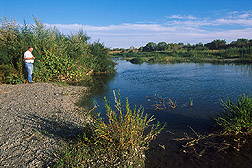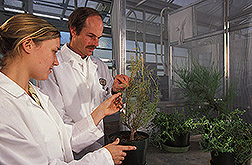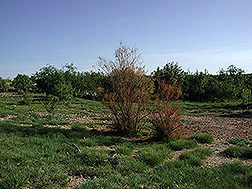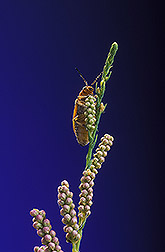Beneficial Beetles Take a Bite Out of Saltcedar
|
|
Can a tiny beetle spell doom for a rugged, aggressive weed that's already invaded streambanks and river channels throughout the American West?
Yes!
That's what ARS scientists and their colleagues have found in their investigations of a leafbeetle, Diorhabda elongata, that they've brought to sites infested with saltcedar, also known as tamarisk.
This salt-tolerant, fire-resistant, drought-hardy water guzzler was imported in the 1800s to help hold stream and river banks in place.
Today, saltcedar's range extends from the Great Plains to the Pacific and from Canada to northern Mexico. It has crowded out native plants such as cottonwoods and willows, disrupting the natural surroundings needed by these plants as well as by birds, fish, and other forms of life.
Saltcedar resprouts vigorously even after the hottest blazes. It blocks river and stream access—by river rafters or thirsty wildlife and livestock—by forming dense, often impenetrable thickets, first as bushy shrubs and, later, as pink-blossomed trees that grow to 30 feet.
In addition, saltcedar plays havoc with watercourses. When rivers and streams overflow their banks, saltcedar bushes can trap natural flood debris, blocking waterflow and causing new, erosive channels to form. These channels sometimes undercut farm roads and fields, causing them to collapse.
But the jaunty beetle, imported from China, Kazakhstan, other parts of Asia, and the Mediterranean region—all lands where the troublesome tree is native—has taken an impressive bite out of saltcedar in several study sites in the West.
To this insect, America's vast stands of saltcedar are just one enormous, seemingly endless banquet. The plant's scale-like leaves offer a nutritious treat for the insects, whether they're in their caterpillar-like larval stage or have matured into quarter-inch-long adult beetles.
Besides thriving on emerging leaves and shoots, the beetles also nibble on the bark of small twigs, all the while posing no hazard to people, pets, or crops. That's according to ARS entomologist C. Jack DeLoach and ARS ecologist Raymond I. Carruthers. DeLoach is based at the Grassland Protection Research Unit in Temple, Texas. Carruthers works in the San Francisco Bay area at the ARS Exotic and Invasive Weeds Research Unit, part of the Western Regional Research Center at Albany, California.
Scoring Big in Lovelock, Nevada
|
|
The beetles' greatest success since first being turned loose in saltcedar stands in 2001 has been along the Humboldt River in Lovelock, Nevada, about 80 miles northeast of Reno. Here, an original colony of some 1,400 laboratory-reared beetles has "expanded exponentially and has now defoliated about 5,000 acres of saltcedar," says Carruthers.
Today, the helpful insects number in the millions. What's more, they've extended their range, spreading at least 100 miles along the Humboldt River—defoliating and stunting saltcedar. Some of those trees are beginning to die.
"We've seen a similar impact in some other study sites in Colorado, Nevada, Utah, and Wyoming, with hundreds of acres of trees hit hard by the beetles," notes Carruthers. He and DeLoach expect that figure to climb to thousands of acres by summer's end.
Experts like Carruthers and DeLoach view biological control agents such as the D. elongata leafbeetle as perhaps the best long-term solution to getting tough with tamarisk.
Of course, the insects represent a considerable investment. Initially, they have to be collected abroad. Then they have to be extensively studied to make sure they don't inadvertently damage other plants. Finally, they have to be put to work outdoors and carefully monitored. Ideally, the beetles will provide an impressive return on these investments.
A Little History
The beetle saga began in the 1970s when ARS entomologist Lloyd A. Andres at Albany, now retired, became concerned about saltcedar's unchecked incursion into agricultural lands in western states. He enlisted the help of colleagues in Asia to search for insects to control the plant.
Entomologist Robert Pemberton—then at an ARS laboratory in South Korea and now with ARS in Fort Lauderdale, Florida—collected D. elongata in China, making him the first to identify this insect's promise as a biological control agent for the United States.
Then followed nearly two decades of pioneering investigations of the beetle and the weed by collaborators Bao Ping Li in China, Roman Jashenko and Ivan Mityaev in Kazakhstan, and DeLoach.
In ARS-led outdoor tests, begun in 1998, beetles were confined with saltcedar and other plants in carport-sized screened cages. "The beetles proved effective in controlling saltcedar and at the same time safe for the environment," Carruthers says. Because the beetles controlled saltcedar but didn't feed on other plants, the scientists received federal and state approvals to turn the beetles loose at test sites in the West.
These studies represent the first time—in the more than 170 years during which tamarisk has run rampant in the United States—that any natural organism had been lined up to challenge this pest.
But much more remains to be done. Though the beetles have established many flourishing colonies, they originally failed to reproduce at southerly test sites, such as those in Texas.
Deceptive Daylengths Confuse Beetles
|
|
Entomologists Phil A. Lewis, formerly at DeLoach's lab, and Daniel Bean of the University of California at Davis, working at Carruthers's lab, discovered the reason for this failure to survive: Mistaking the region's shorter days as a signal of winter's approach, the beetles went into hibernation, called diapause, in July—2 months too early. The mistake was fatal. The following year, they never woke up to complete their life cycle. Without enough fat reserves in their bodies to tide them over until saltcedar leafed out in spring, they starved to death.
To help solve this problem, ARS scientists and collaborators collected D. elongata from Uzbekistan through Greece to Tunisia, where daylengths better align with those of the American Southwest.
"These southern-adapted beetles," says DeLoach, "are now defoliating saltcedars in California, Texas, and New Mexico," where ARS and university scientists are monitorning their progress.
|
|
Spying From the Sky
Now, the researchers are streamlining tactics to track the spread and success of the hungry insects. For example, ARS remote-sensing specialists Jim Everitt of Weslaco, Texas, and Gerald Anderson of Sidney, Montana, are using a trio of technologies to spy on the beetle and the plant.
This technological mix includes color aerial photography and two types of scanner-derived aerial imagery, hyperspectral and multispectral.
All have helped the saltcedar scientists assess the beetle's work. Monitoring the beetle's progress also entails scouting—on foot. That job may be less of a hassle in the near future, thanks to a new, ARS-developed lure that beetles can't seem to resist. (See "Tracking an Attacker—of Saltcedar" in this issue.)
The intensive studies of the diminutive beetle have revealed other secrets about it. For example, what's been regarded as merely one species of beetle—with biotypes adapted to different areas—may actually be several different species. (See Forum "Saltcedar Scientists Trounce Troublesome Tree" in this issue.)
Too, the work has underscored the need for other biocontrol agents to complement the beetle. Those studies are being carried out at the ARS European Biological Control Laboratory, in Montpellier, France.
Setting New Records
ARS's tamarisk-taming studies link with efforts of others in the national Saltcedar Biological Control Consortium. Specialists from federal, tribal, state, regional, and environmental organizations are involved in tackling this weed. That makes this consortium likely the largest of its kind ever established in this country.
Also unparalleled in the history of U.S. biological control of weeds are the international scope of the research, the variety of ecosystems ARS scientists have scrutinized in their studies of the beetle, and the number of states encompassed in the outdoor tests.
Perhaps in another few years, this carefully orchestrated campaign to stop saltcedar's spread may become one of America's most remarkable biological control successes.—By Marcia Wood and Don Comis, Agricultural Research Service Information Staff.
This research is part of Crop Protection and Quarantine, an ARS National Program (#304) described on the World Wide Web at www.nps.ars.usda.gov.
C. Jack DeLoach is in the ARS Grassland Protection Research Unit, 808 E. Blackland Rd., Temple, TX 76502; phone (254) 770-6531, fax (254) 770-6561.
Raymond I. Carruthers is in the USDA-ARS Exotic and Invasive Weeds Research Unit, Western Regional Research Center, 800 Buchanan St., Albany, CA 94710; phone (510) 559-6127, fax (510) 559-5737.
"Beneficial Beetles Take a Bite Out of Saltcedar" was published in the April 2005 issue of Agricultural Research magazine.











